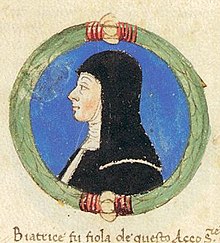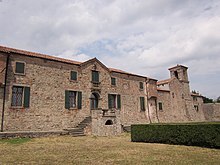Beatrice I. d'Este
Beatrice I. d'Este (* 1191 or 1192 in Baone or Este , † May 10, 1226 in Baone) was an Italian noblewoman and nun . 1763 she was by Pope Clement XIII. beatified.
biography
Beatrice I. d'Este comes from the noble family Este , prior to their resettlement in Ferrara in 1239, the city Este and parts of the area around Padua dominated. Her parents were Azzo VI. d'Este and his second wife Sofia of Savoy , daughter of Humbert III. Her mother died in 1202. Beatrice spent her childhood and youth in the castles of Este and Calaone (three kilometers from Este in the Colli Euganei ), together with her two half-brothers from her father's first marriage, Aldobrandino and Azzo , and hers younger half-sister Constanza. This came from the third marriage of her father to Alisia of Antioch , daughter of the French crusader Rainald von Chatillon (around 1125-1187) and his wife Klementia von Zähringen, who was probably a granddaughter of Duke Konrad I of Zähringen (1090-1152).
Beatrice enjoyed the court life. Her virtues and her beauty were sung about by troubadours , especially by Rambertino Buvalelli , who dedicated nine poems to her and referred to her as mon restaur ( Occitan meaning my refreshment ). Beatrice's father sought a political marriage for her.
Armed conflicts between the Ghibellines loyal to the emperor and the Guelphs loyal to the Pope ended Beatrice's carefree youth: in 1212 her father, a partisan of the Guelphs, was killed in a battle against troops loyal to the emperor in Pontalto . A few months later Este was besieged and finally had before from Padua formers , Vicentinern and Bassa formers composite army under the leadership of Ezzelino II. Da Romano surrender. Aldobrandino, Beatrice I. d'Este's older brother, was killed (possibly poisoned) in 1215, and her sister Constanza died in the same year. Since the family had borrowed from Florentine bankers to finance a campaign to conquer the Mark Ancona , they took Azzo, Beatrice's underage half-brother, hostage until the following year. In order to trigger it again, the family had to give up real estate.
Presumably because of these events and the deaths in her family, Beatrice chose a monastic life. She withdrew to the convent of the Benedictine Sisters of Santa Margherita on Monte Salarola in Calaone, where she lived for a year and a half, probably with the support of Giovanni Forzaté , the prior of the convent of St. Benedict in Padua and later bishop, as well as the prior Alberto di Montericco. There was strong pressure on her from family, relatives and friends to leave the monastery because her marriage to Margrave Guglielmo Malaspina was planned. Beatrice managed to postpone the planned wedding date until the margrave died in 1220. Her resistance to the marriage policy of a powerful noble family and her retreat into a monastery caused a sensation at the time.
After she finally convinced her family, Beatrice d'Este received buildings on Mount Gemola near Baone from the Bishop of Este in the middle of 1221, which were previously inhabited by hermits and now abandoned. There she founded a women's community who lived according to the Benedictine Rule , but refused to be appointed as abbess of the convent herself . The convent was established in the presence of Forzaté, Abbot Alberto, her stepmother Alisia and her sister-in-law Giovanna di Puglia, as well as other believers, who led them there on foot. She used her fortune to have the monastery building and the church, which had been empty for a long time, repaired.
The new community attracted around a dozen other high-ranking noble women, including the blessed Giuliana di Collalto , who was later buried in Sant'Eufemia on Giudecca near Venice . The women led a meager life of penance, prayer, fasting and poverty. This strict lifestyle undermined the health of Beatrice d'Este and she died of tuberculosis in 1226 at the age of 34 . Her body was buried in a sarcophagus in the small church of the monastery until the convent was abolished in 1578. The nuns moved to Santa Sofia in Padua , where the Beatrice sarcophagus was first transferred.
Adoration
On November 19, 1763, Pope Clement XIII spoke . Beatrice d'Este, around whom numerous legends entwine, blessed . In May 1957, the sarcophagus and her remains were opened in the presence of Angelo Roncalli, then Patriarch of Venice and later Pope John XXIII. After Este transferred , where they have since the Duomo di Santa Tecla can be venerated in a glass shrine as relics. The blessed Beatrice is the second patron saint of the city , alongside St. Tekla , who, according to tradition, saved the city from the plague . The altar dedicated to her is crowned by a large 19th century essay, the work of the painter Michelangelo Grigoletti . Every year on the feast of the Blessed on May 10th, objects and robes belonging to Beatrice d'Este are displayed in the cathedral.
swell
The biographical data come from the biography Vita Beatae Beatricis , written by Alberto from Verona (not identical with Alberto di Montericco). The text was unknown for centuries until it was rediscovered and published by the abbot and historian Giovanni Brunacci in the 18th century . The only manuscript of the document that was given to her niece of the same name (Beatrice II. D'Este) in 1256 is kept in the Biblioteca Estense Universitaria in Modena .
museum
After the nuns left the monastery buildings in 1578, they were acquired by the Venetian merchant Francesco Ruberti, who had them converted into a country villa. At the beginning of the 20th century, a barn was built on the ruins of the monastery church. In 1972 the Colli Euganei Consortium of the Province of Padua bought the property and set up the natural history museum Museo Naturalistico di Villa Beatrice in the rooms .
rose
At the request of the city of Este, the rose growers Georges Delbard created the yellow- apricot-colored tea hybrid Beatrice I d'Este in 2005 .
Other namesake women
Beatrice d'Este is one of several bearers of this name in her family.
Two of her nieces had the same name ( Beatrice II. D'Este and Beatrice III. D'Este ). Beatrice II (around 1226–1262) was a daughter of Azzo VII and founder of the monastery, who was also beatified, Beatrice III. (1215–1245) a daughter of Aldobrandino. She became Queen of Hungary and, although not formally canonized, is also venerated as a blessed; she died in the monastery founded by her aunt on Monte Gemola.
Another well-known name bearer is Beatrice d'Este , who lived in the 15th century and was married to Ludovico Sforza .
Web links
- Beata Beatrice I d'Este (1191-1226). In: mapio.net. Retrieved July 5, 2018 .
- Bibliography on Beatrice d'Este. In: bpa.pd.it. Retrieved July 24, 2018 .
Individual evidence
- ↑ a b c d e f g h i j k l m Lorenzo Paolini: ESTE, Beatrice d '. In: Fiorella Bartoccini (ed.): Dizionario Biografico degli Italiani (DBI). Volume 43: Enzo – Fabrizi. Istituto della Enciclopedia Italiana, Rome 1993.
- ↑ a b c d e The salty Beatrix d'Este (I) (≈1200–1226): The salty Beatrix d'Este (I) (≈1200–1226) - Den katolske kirke. In: katolsk.no. Retrieved July 5, 2018 (Norwegian).
- ^ Antonio Borrelli: Beata Beatrice I d'Este su. In: santiebeati.it. October 14, 2002, accessed July 5, 2018 .
- ^ Beata Beatrice la figlia di Azzo VI che lasciò la corte. In: Il Mattino di Padova. June 21, 2014, accessed July 24, 2018 (Italian).
- ↑ Duomo di Santa Tecla a Este. In: collieuganei.it. Retrieved July 5, 2018 .
- ^ Villa Beatrice d'Este al monte Gemola a Baone, sistema museale Provincia di Padova, Parco Naturale Regionale dei Colli Euganei, Museo Naturalistico Villa Beatr. In: magicoveneto.it. Retrieved July 24, 2018 (Italian).
- ^ Villa Beatrice D'Este sul monte Gemola a Baone. In: collieuganei.it. Retrieved July 24, 2018 .
- ↑ La rosa Beatrice d'Este. In: Il Mattino di Padova. April 27, 2004, accessed July 24, 2018 (Italian).
- ↑ Agate Rosiers Béatrice I d'estée ® - Vente de nos créations et productions Georges Delbard. In: georgesdelbard.com. Retrieved July 24, 2018 .
- ↑ **: ESTE, Beatrice d ', regina d'Ungheria. In: Fiorella Bartoccini (ed.): Dizionario Biografico degli Italiani (DBI). Volume 43: Enzo – Fabrizi. Istituto della Enciclopedia Italiana, Rome 1993.
| personal data | |
|---|---|
| SURNAME | Beatrice I. d'Este |
| BRIEF DESCRIPTION | Italian noblewoman and Benedictine woman |
| DATE OF BIRTH | 1191 or 1192 |
| PLACE OF BIRTH | Baone or Este |
| DATE OF DEATH | May 10, 1226 |
| Place of death | Baone |




